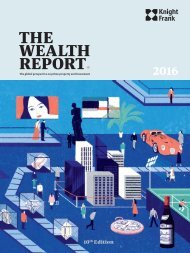MODERN MASTERPIECES
PrivateviewT12
PrivateviewT12
Create successful ePaper yourself
Turn your PDF publications into a flip-book with our unique Google optimized e-Paper software.
OPPOSITE<br />
The Grade 1-listed Pulteney Bridge, top left,<br />
The Circle’s ornate architecture, Bath,<br />
below; bucolic bliss in Wiltshire, top right<br />
THIS PAGE, LEFT TO RIGHT<br />
The vista over Edinburgh from the Dugald<br />
Stewart Monument; stately country-house<br />
grandeur in Inveresk, East Lothian<br />
EXPERT’S<br />
VIEW<br />
What’s happening in the PRIME COUNTRY MARKET? Knight Frank’s<br />
Head of UK Residential Research ANALYSES THE EVIDENCE<br />
WORDS by GRÁINNE GILMORE<br />
The architecture and design of the best<br />
homes across the land reflect their<br />
age and location. Location is also key when<br />
it comes to property values, and age plays<br />
a part, but the price band of the home is<br />
becoming increasingly influential in<br />
determining price trends.<br />
Macro-economic and political factors also<br />
sway the market as a whole. The appointment<br />
of a new Prime Minister and Cabinet earlier<br />
in the summer, for example, following political<br />
uncertainty in the wake of the vote by the UK<br />
to leave the European Union, was greeted with<br />
positivity and viewed as preferential to months<br />
of campaigning by Conservative candidates.<br />
Transactions in the prime country market<br />
have continued apace since Brexit, with<br />
evidence of price renegotiations in some<br />
instances. The relative value of sterling has<br />
also been a boon for buyers using dollars or<br />
other overseas currencies to purchase a home,<br />
providing an effective discount on the price<br />
of bricks and mortar. The relative value of<br />
TIM GARTSIDE/ALAMY; PEET SIMARD/GETTY IMAGES; MARCO WONG/GETTY IMAGES<br />
the prime country market compared to<br />
prime London has also resulted in a ripple<br />
effect as buyers move from the capital to<br />
the country, boosting demand. This trend<br />
is expected to continue.<br />
However, the referendum and its impact<br />
on the prime property market cannot be<br />
viewed in isolation. Other policy decisions,<br />
such as four major changes to Stamp Duty<br />
Land Tax levied on the most valuable homes<br />
over the past five years, have also affected the<br />
market. There was a notable surge of activity<br />
in March this year, as buyers pushed through<br />
deals before 1st April – the date of the most<br />
recent levy, an extra 3% duty on additional<br />
homes – came into effect. The market has<br />
absorbed such changes in the past, but it is<br />
usually a process that takes place by degrees,<br />
over a matter of months.<br />
But amid these developments, what has<br />
been happening to pricing in the market? Just<br />
as there is no one perfect country home, there<br />
is no one figure that can fully encapsulate the<br />
The relative value of<br />
the prime country<br />
market compared<br />
to prime London<br />
has resulted in<br />
a ripple effect<br />
prime country-homes market. Our Prime<br />
Country House Index, which has been running<br />
for more than two decades and is compiled<br />
by analysing figures from our surveyors in<br />
31 residential offices across the UK, is one of<br />
the best indicators of the direction of travel<br />
in the market. It shows price growth of 1.3%.<br />
Drilling down below the headline figures,<br />
several distinct trends emerge. Perhaps the<br />
most notable of these in recent years has been<br />
the outperformance of prime properties closer<br />
to urban locations compared to those in more<br />
rural settings. Prices in Cheltenham, for<br />
example, rose by 8.6% in the year to the end<br />
of June (reflecting the market before the EU<br />
referendum vote), while prices in Bath are up<br />
by 4.8% over the same period. Prime price<br />
growth in Edinburgh is also outstripping that<br />
in the wider Scottish market.<br />
Access to schools and transport hubs are<br />
among the attractions of more urban markets,<br />
especially those within commuting distance of<br />
London. While the price differential between<br />
London and country homes has encouraged<br />
more people to make a move from the capital,<br />
in many cases, one or more members of the<br />
household will still need to travel back in for<br />
work on a regular basis.<br />
However, there are some trends that unite<br />
many local markets – and one of these is a<br />
continued lack of stock. The relative decline in<br />
vendors putting their homes on the market<br />
in recent years, particularly in more urban<br />
locations, has underpinned pricing in some<br />
respects. This was especially noticeable in<br />
the months preceding the referendum, when<br />
buyers as well as vendors chose to ‘wait and<br />
see’ rather than enter the fray of the market.<br />
There is also a distinct difference in<br />
performance across price brackets. Again,<br />
some of this can be attributed to the market<br />
having adjusted to higher stamp-duty charges.<br />
In the year to June, the price of prime country<br />
properties worth more than £5m fell by 7.9%,<br />
while those for properties worth £1m–2m rose<br />
by 1.4%, and those worth £2–3m by 1.7%.<br />
It is worth adding that the one thing hard<br />
data struggles to capture is the lifestyle buyers<br />
are choosing when they invest in a prime<br />
country property: it may be a tangible asset,<br />
but it’s first and foremost a home.<br />
2016 19



